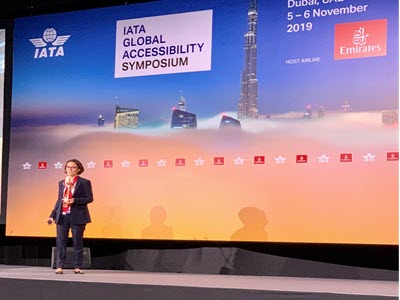IATA Global Accessibility Symposium sets new benchmarks for inclusive air travel
- Written by George Sensalis
 IATA’s first-ever Global Accessibility Symposium resulted in a ground-breaking event, one that set new benchmarks in the field of accessible air travel.
IATA’s first-ever Global Accessibility Symposium resulted in a ground-breaking event, one that set new benchmarks in the field of accessible air travel.
A benchmark is a standard used as a point of reference for evaluating performance or level of quality. Benchmarks may be drawn from an entity's own experience, from the experience of other stakeholders in the industry.
IATA, the global airlines’ association, brought together regulators, operators, accessible air travel experts, and persons with disabilities to discuss the state of play of accessible air travel and begin drafting a way forward.
Hosted by Emirates in their home city of Dubai, the Symposium is in line with an industry resolution agreed upon by IATA member airlines in June 2019, which commits to further improving the passenger experience for travelers with disabilities, both visible and invisible.
"This event showed that collaboration and feedback are crucial. Through this gathering and other initiatives, airlines are  seeking to establish a better dialogue between industry, advocacy groups, and passengers themselves. While the industry has had standards for persons traveling with disabilities for some time, we realize there are still gaps and we need to do more. We're excited to be on this journey to make air travel more accessible and inclusive," said Linda Ristagno, External Affairs Manager at IATA.
seeking to establish a better dialogue between industry, advocacy groups, and passengers themselves. While the industry has had standards for persons traveling with disabilities for some time, we realize there are still gaps and we need to do more. We're excited to be on this journey to make air travel more accessible and inclusive," said Linda Ristagno, External Affairs Manager at IATA.
In addition to speakers from airlines including British Airways, Delta Air Lines, Emirates, and WestJet, presenters came from a wide variety of backgrounds such as regulatory bodies like the UK CAA, Canadian Transport Agency and Brazilian Ministry of Infrastructure; advocacy groups such as the Reduced Mobility Rights, the Pineda Foundation / World Enabled, the European Network on Accessible Tourism, Open Doors Organization and Queen Elizabeth's Foundation for Disabled People; as well as a number of industry partners including dnata and Heathrow Airport.
Presentations were also given by representatives from Apple and Microsoft showing the importance of inclusive design and technological innovation.
 The event featured keynotes and panel discussions that addressed a wide variety of accessibility and inclusion topics. Some of the key issues raised during the Symposium included:
The event featured keynotes and panel discussions that addressed a wide variety of accessibility and inclusion topics. Some of the key issues raised during the Symposium included:
Global policy consistency needed for work on accessibility and inclusion in aviation including airline/ground processes and government regulation, better understanding needed for the requirements of travelers with hidden disabilities, improved and standardized processes needed to streamline the handling of mobility aids as the damage rate is too high.
The importance of training was recognized, especially for passenger-facing roles, to ensure inclusive, empathetic and human-centric service is delivered to travelers with disabilities.
Inconsistencies in security policies across airports and states for passengers with disabilities need to be addressed.
The findings and results of this event will be used to build upon the existing IATA accessibility strategy that will lead to clear deliverables while continuing the dialogue with passengers, airports, and governments.
"It is a step in the right direction, but the work isn't done. We will continue to facilitate the discussion and refine the industry strategy from here. However, we need governments to help by developing harmonized regulations, in consultation with industry and accessibility groups, that provide clarity and global consistency. Working together will help ensure a safe, reliable and dignified experience that we owe to these passengers," said Ristagno.










